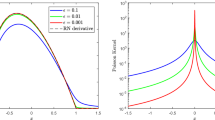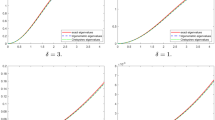Abstract
A method for constructing spectral analogues of physical phenomena models is proposed and investigated. The developed approach utilizes integral transformations and is based on the consideration of functions of one real argument as vectors of an infinite-dimensional linear space with an uncountable basis. The value of the argument is interpreted as the number of the component of such a vector, and the value of the function is understood as the value of the corresponding component. In turn, functions of two or more arguments correspondingly are considered as tensors of the 2nd and higher ranks. From this point of view, any integral transformation is interpreted as replacing one uncountable basis with another. To make this interpretation possible, the corresponding vector spaces with bases are being constructed and possible bases changes are discussed. Finally, the approach being considered is applied to the derivation of the spectral equations of the fluid model. The attempt is being made to find out the geometric meaning of conservation laws and balance equations which constitute the model and understand how they change under integral transformation. Next, these equations are being rewritten in new terms, and their spectral analogues are derived. The proposed interpretation is new and allows one to look at the space-time equations of physical models and their spectral analogues from a unified point of view.



Similar content being viewed by others
Notes
When constructing a model of continuum, this equation is a part of the model and is called the continuity equation (here, one-dimensional). In the next section, this equation is derived from the mass conservation law.
Here differentiation means calculation of the quotient of the increment of the function to the corresponding time increment.
Close reasoning can be found in [6] Sect. 3.4.4.
Thus, the value of a basis c1-form \(\tilde{\sigma }^{y}\) on a basis c-vector \(\bar{e}_{x}\), which is equal to \(\delta _{x}^{y}=\delta (y-x)dx\), is interpreted as a component of a basis object in two ways depending on the context, either as a component of a c-vector or as a component of a c1-form with respect to the corresponding basis.
These equations will be derived in the next section.
This is a condition of the lack of intersections of world lines.
Such interpretation is possible since the phase flux is defined by condition \(\left| \vec {v}\right| =1\) everywhere on the world-tube and thus the energy of the world-tube cross-section is equal numerically to the half of its mass.
Unlike any point of a physical body which may be regarded to exist eternally and whose world-line has an unlimited duration in time, we consider a world-tube of a body to be finite and using some external considerations we call two cross-sections of the world-tube of a body as its beginning and end. For example, one may consider as such, the change of connectivity of a world-tube cross-section or decrease of the mass density below a certain threshold value, etc.
In the theory of waves, the function \(\omega (\mathrm{k})\) is called the dispersion relation.
The inverse quantity \(\nabla _{\mathrm{k}}\omega \equiv (\partial _{k_{1}}\omega , \partial _{k_{2}}\omega ,\partial _{k_{3}}\omega )\) is called the group velocity.
Hereafter we shall use a brief notation \(e_{\mathrm{x}}=\bar{e}_{x^{1}}\otimes \bar{e}_{x^{2}}\otimes \bar{e}_{x^{3}}\). Besides, quantities related to different variants of description will be marked with lower or upper indices, E (for the Euler description) and L (for Lagrangian description).
References
Bochner, S., Chandrasekharan, K.: Fourier Transforms. Princeton University Press, Princeton (1949)
Osgood, B.: Lectures on the Fourier Transform and Its Applications. AMS Publisher, Providence (2019)
Zakharov, V.E.: Stability of periodic waves of finite amplitude on the surface of a deep fluid. J. Appl. Mech. Tech. Phys. 9(2), 190–194 (1968/1972)
Yuen, H.C., Lake, B.M.: Nonlinear dynamics of deep-water gravity waves. Adv. Appl. Mech. 22, 67–229 (1982)
Hutson, V.C.L., Pym, J.S., Cloud, M.J.: Applications of Functional Analysis and Operator Theory, 2nd edn. Elsevier, New York (2005)
Richtmyer, R.D.: Principles of Advanced Mathematical Physics, vol. 1. Springer, New York (1978)
Kurosh, A.G.: Lectures on General Algebra. Elsevier, New York (1963)
Belevich, M.: On physical limitations of mathematical constructions used in mathematical models. Pramana J. Phys. 93, 33 (2019). https://doi.org/10.1007/s12043-019-1788-1
Wolf, K.B.: Integral Transforms in Science and Engineering. Plenum Press, New York (1979)
Belevich, M.: Causal description of non-relativistic dissipative fluid motion. Acta Mech. 161, 65–80 (2003)
Belevich, M.: On the spectral form of the fluid mechanics equations. II. Functions as infinite dimensional tensors. Proc. RSHU 38, 59–65 (2015). in Russian
Belevich, M.: On the spectral form of the fluid mechanics equations. III. Integral transforms as the change of the basis. Proc. RSHU 40, 81–95 (2015). in Russian
Acknowledgements
I am grateful to my colleagues Dr. A. Holmstock and N. Volzinger for their helpful discussions and valuable comments. This research was carried out in the framework of the theme 0128-2021-0014 of the Shirshov Institute of Oceanology, Russian Academy of Sciences, Moscow, Russia.
Funding
This research was carried out in the framework of the theme 0128-2021-0014 of the Shirshov Institute of Oceanology, Russian Academy of Sciences, Moscow, Russia.
Author information
Authors and Affiliations
Corresponding author
Ethics declarations
Conflicts of interest
The author declare that there is no conflict of interests.
Additional information
Publisher's Note
Springer Nature remains neutral with regard to jurisdictional claims in published maps and institutional affiliations.
Rights and permissions
About this article
Cite this article
Belevich, M. On the spectral description of physical phenomena. Ricerche mat 73, 481–530 (2024). https://doi.org/10.1007/s11587-021-00620-1
Received:
Accepted:
Published:
Issue Date:
DOI: https://doi.org/10.1007/s11587-021-00620-1




